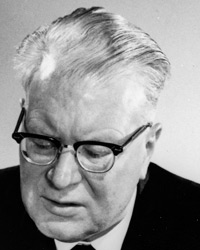Chester Carlson
American inventor (1906 - 1968)

- || At The Bottom
1930 -- Chester Carlson's early life was almost too horrible to be believed. The son of a barber, Carlson was born in Seattle but lived an uprooted life as his father moved the family from one new place to another along the west coast, seeking work from Washington to Mexico before eventually landing in San Bernardino. Both of his parents suffered chronic health problems. Both had tuberculoses, while his father was afflicted as well with spinal arthritis. Carlson's mother died of TB when he was a junior in high school, a loss that he never truly overcame. His mother's death meant that he would have to care for his father full time. Carlson found a job working at the San Bernardino County poor farm. He and his father lived in an old chicken coop -- a single-room with a concrete floor that reverberated with the constant sound of his father's coughing. Carlson, afraid of catching the disease that had killed his mother, lived outside the coop, in a hut he built from scrap lumber. In high school, he earned good grades in science and fancied himself as a future inventor. After high school, he worked his way through three years of junior college before transferring and earning a degree in physics from California Institute of Technology. Seemingly cursed, Carlson graduated in 1930 as the Depression was beginning to choke the life out of the US economy. After sending out more than eighty letters to companies around the United States, Carlson landed a job with Bell Labs in New York city for a mere $35 a week. After a few weeks at Bell, Chester received the news that he was being laid off.
- || At The Top
1965 -- On May 7, 1965, Chester Carlson was presented with a gold key by the Patent, Trademark and Copyright Institute, which was honoring him as "Inventor of the Year." Carlson had just received word that his 37th patent had been accepted by the US Patent Office in Washington DC. Carlson's most famous invention, electrostatic photocopying, had earned him over $150 million and made "Xerox" -- the company that developed Carlson's ideas -- one of the most important names in business. Before his untimely death of a heart attack in 1968, Carlson anonymously gave away about two-thirds of his earnings (about $700 million in today's dollars) to the NAACP and other civil rights organizations, as well as to the American Civil Liberties Union. In 1981, Carlson was inducted into the National Inventors Hall of Fame.
- || The Comeback
After being laid off from Bell, Carlson realized he would probably have to look for work outside his field of training and expertise. After a while, he was fortunate to find a job in the patent department at P.R. Mallory, an electronics company best known for producing dry cell batteries (Mallory eventually became Duracell). Carlson's job was boring, but it gave him an income and time to think about a problem that he had taken an interest in: how to produce copies of documents without relying on the inefficient and expensive processes currently in use. As a physicist, Carlson had the mindset to solve complex problems, and he'd always wanted to invent something useful. So he set up a lab in his kitchen, to the annoyance of his wife (who eventually left him). By 1937, he had figured out how to reproduce images by projecting them onto a sulfur-coated zinc plate, then sprinkling it with fungal spores and transferring the copied image to wax paper. It was a cumbersome process, but it worked. After patenting the process, Carlson shopped the idea to nearly two dozen large corporations -- including IBM, Kodak, General Electric and RCA -- all of whom took a pass. Finally, in 1947, Carlson signed an agreement with a small company in Rochester, New York, called Haloid. After improving the process and naming it "xerography," Carlson's invention was introduced to the world as the Xerox copier. By 1959, Haloid had introduced the first automated copier; by 1965, the company had changed its name to Xerox and was raking in more than $500 million a year in revenue.



